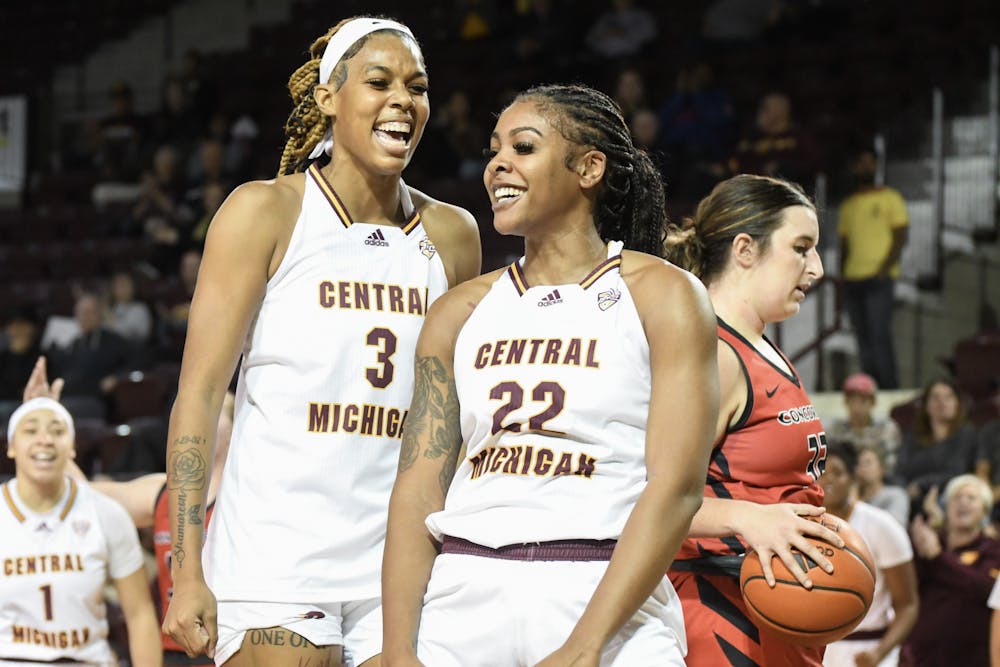COLUMN: Leveling the Playing Field

CMU freshman center Desrae Kyles (left) and CMU graduate student forward Nadége Jean (right) celebrate Jean's basket during the women's basketball game against Concordia-Ann Arbor Tuesday, Nov. 14 in McGuirk Arena. Jean accomplished a career high during the game, with 15 points, seven rebounds and two blocks. (Ella Miller | CM Life)
In collegiate athletics over the years, the rivalries have become bigger, and the fans have become rowdier. Yet, amidst the fun a divide remains between men and women through the struggle for gender equality in college sports.
Over the years, strides have been made to close the gender gap and to level the playing field, including Title IX, which shows an attempt at making progress with this issue. It helped mandate equal opportunities for both male and female athletes in federally funded educational institutions. This paved the way for an increase in participation in women’s collegiate sports, bringing a culture of empowerment and inclusivity.
Although legal stances have been taken, the fight for gender equality among collegiate athletes remains on the rise. The differences in funding, resources and exposure between men’s and women’s sports are examples of the fight that continues. While football and men’s basketball remain the most watched sports in the NCAA, they revenue away from other teams that are mostly dominated by female athletes through coverage, facilities and even the amount of people on the team.
Throughout all divisions in the NCAA, women’s participation is over 11% lower than men’s participation. Although Title IX ensures that men’s and women’s sports both have equal opportunity, men’s athletics has had significantly more opportunities than women’s.
The country first saw a breakthrough when the 2023 Louisiana State University women’s basketball team won the NCAA national championship against Iowa. The game saw more than 12.6 million viewers, hitting a record high, while the men’s national championship which saw the University of Connecticut defeat San Diego State University, hit a record low reaching 14.69 million. Many people deemed that the women’s tournament was increasingly more interesting than the men’s tournament that year.
To achieve true equality, it’s important to address disparities head-on. Equal access to facilities, equipment and resources should be a fundamental right. Additionally, the amount of social media exposure and coverage should be equivalent, but there proves to still be a lack of coverage which leads to a lack of fan engagement in women’s athletics.
At Central Michigan, social media sites connected to athletics seem to highlight the successes of male athletes over women. The football team is hosted on cable networks like ESPNU, while women’s soccer and basketball are getting coverage on subscriber-only networks like ESPN+ that don’t get nearly the same revenue.
Recently, high school female athletes have been known to participate in “male-dominated” sports like wrestling and even football. It’s more common to see women taking on kicker positions on nearly a 100-man roster. This year, Division One football saw the first female team member take the field at Jackson State University.
Moreover, fostering a society that can celebrate female athletes’ achievements instead of just their performance is important to maintaining equality. Recognizing their leadership, resilience and dedication both on and off the field inspires others and brings more attention to these female athletes, encouraging more women to get involved in college athletics.
With all these factors, there is one important aspect that can guide society to an uptick in collegiate gender equality. Breaking free from stereotypes that pigeonhole certain sports into gender-specific categories is crucial. Embracing a culture where all athletes strive and have no gender boundaries will be pivotal in developing exposure to gender equality.
As we navigate the world of collegiate sports, instead of focusing solely on the outcome of the game, it’s important to focus also on the treatment, recognition and opportunities being implemented for all athletes. The road to gender equality in college sports is faced with challenges, but each step forward brings us closer to a future where fairness, respect and inclusivity prevail and where the playing field is level for all.



